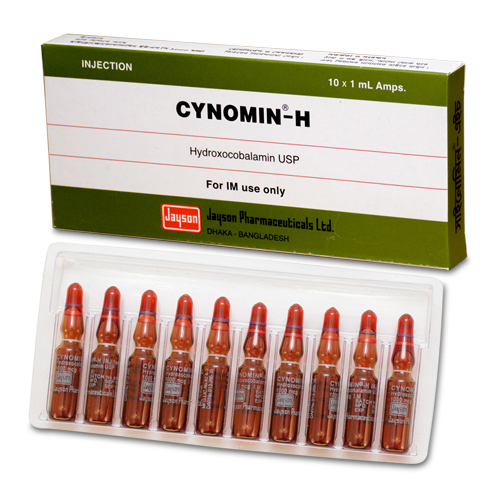1 ml ampoule:
৳ 30.09
(2 x 5: ৳ 300.90)
Indications
Cynomin-H is indicated for the treatment of known or suspected cyanide poisoning.
Identifying Patients with Cyanide Poisoning: Cyanide poisoning may result from inhalation, ingestion, or dermal exposure to various cyanide-containing compounds, including smoke from closed-space fires. Sources of cyanide poisoning include hydrogen cyanide and its salts, cyanogenic plants, aliphatic nitriles, and prolonged exposure to sodium nitroprusside.
The presence and extent of cyanide poisoning are often initially unknown. There is no widely available, rapid, confirmatory cyanide blood test. Treatment decisions must be made on the basis of clinical history and signs and symptoms of cyanide intoxication. If clinical suspicion of cyanide poisoning is high, Cynomin-H should be administered without delay.
In some settings, panic symptoms including tachypnea and vomiting may mimic early cyanide poisoning signs. The presence of altered mental status (e.g., confusion and disorientation) and/or mydriasis is suggestive of true cyanide poisoning although these signs can occur with other toxic exposures as well.
Smoke Inhalation: Not all smoke inhalation victims will have cyanide poisoning and may present with burns, trauma, and exposure to other toxic substances making a diagnosis of cyanide poisoning particularly difficult. Prior to administration of Cynomin-H, smoke-inhalation victims should be assessed for the following:
Use with Other Cyanide Antidotes: Caution should be exercised when administering other cyanide antidotes simultaneously with Cynomin-H, as the safety of co-administration has not been established. If a decision is made to administer another cyanide antidote with Cynomin-H, these drugs should not be administered concurrently in the same intravenous line.
Identifying Patients with Cyanide Poisoning: Cyanide poisoning may result from inhalation, ingestion, or dermal exposure to various cyanide-containing compounds, including smoke from closed-space fires. Sources of cyanide poisoning include hydrogen cyanide and its salts, cyanogenic plants, aliphatic nitriles, and prolonged exposure to sodium nitroprusside.
The presence and extent of cyanide poisoning are often initially unknown. There is no widely available, rapid, confirmatory cyanide blood test. Treatment decisions must be made on the basis of clinical history and signs and symptoms of cyanide intoxication. If clinical suspicion of cyanide poisoning is high, Cynomin-H should be administered without delay.
In some settings, panic symptoms including tachypnea and vomiting may mimic early cyanide poisoning signs. The presence of altered mental status (e.g., confusion and disorientation) and/or mydriasis is suggestive of true cyanide poisoning although these signs can occur with other toxic exposures as well.
Smoke Inhalation: Not all smoke inhalation victims will have cyanide poisoning and may present with burns, trauma, and exposure to other toxic substances making a diagnosis of cyanide poisoning particularly difficult. Prior to administration of Cynomin-H, smoke-inhalation victims should be assessed for the following:
- Exposure to fire or smoke in an enclosed area
- Presence of soot around the mouth, nose or oropharynx
- Altered mental status
Use with Other Cyanide Antidotes: Caution should be exercised when administering other cyanide antidotes simultaneously with Cynomin-H, as the safety of co-administration has not been established. If a decision is made to administer another cyanide antidote with Cynomin-H, these drugs should not be administered concurrently in the same intravenous line.
* রেজিস্টার্ড চিকিৎসকের পরামর্শ মোতাবেক ঔষধ সেবন করুন
Pharmacology
Vitamin B12 with hydroxyl group complexed to cobalt which can be displaced by cyanide resulting in cyanocobaiamin that is renally excreted.
Dosage & Administration
Thirty mcg daily for 5 to 10 days followed by 100 to 200 mcg monthly injected intramuscularly. If the patient is critically ill, or has neurologic disease, an infectious disease or hyperthyroidism, considerably higher doses may be indicated. However, current data indicate that the optimum obtainable neurologic response may be expected with a dosage of vitamin B12 sufficient to produce good hematologic response. Children may be given a total of 1 to 5 mg over a period of 2 or more weeks in doses of 100 mcg, then 30 to 50 mcg every 4 weeks for maintenance.
* রেজিস্টার্ড চিকিৎসকের পরামর্শ মোতাবেক ঔষধ সেবন করুন
Interaction
- history of interaction with ARI Sodium Iodide (II23) 1 -12 MBq (sodium iodide i-123)
- ARI Sodium Iodide (1123) 100-750 MBq (sodium iodide i-123) arsenic trioxide
- Chloracol (chloramphenicol) chloramphenicol
- Chloromycetin (chloramphenicol)
- Chloromycetin Sodium Succinate (chloramphenicol)
- Hicon (sodium iodide-i-131) lodotope (sodium iodide-i-131) sodium iodide i-123 sodium iodide-i-131 Trisenox (arsenic trioxide)
Contraindications
Hypersensitivity to any component of this medication.
Side Effects
Mild transient diarrhea, itching, transitory exanthema, feeling of swelling of entire body, and anaphylaxis. A few patients may experience pain after injection of Cynomin-H.
Pregnancy & Lactation
Pregnancy Category C. Animal reproduction studies have shown an adverse effect on the fetus and there are no adequate and well-controlled studies in humans, but potential benefits may warrant use of the drug in pregnant women despite potential risks
Precautions & Warnings
The validity of diagnostic vitamin B12 or folic acid blood assays could be compromised by medications, and this should be considered before relying on such tests for therapy.
Vitamin B12 is not a substitute for folic acid and since it might improve folic acid deficient megaloblastic anemia, indiscriminate use of vitamin B12 could mask the true diagnosis.
Hypokalemia and thrombocytosis could occur upon conversion of severe megaloblastic to normal erythropoiesis with B12 therapy. Therefore, serum potassium levels and the platelet count should be monitored carefully during therapy.
Vitamin B12 deficiency may suppress the signs of polycythemia vera. Treatment with vitamin B12 may unmask this condition.
Vitamin B12 is not a substitute for folic acid and since it might improve folic acid deficient megaloblastic anemia, indiscriminate use of vitamin B12 could mask the true diagnosis.
Hypokalemia and thrombocytosis could occur upon conversion of severe megaloblastic to normal erythropoiesis with B12 therapy. Therefore, serum potassium levels and the platelet count should be monitored carefully during therapy.
Vitamin B12 deficiency may suppress the signs of polycythemia vera. Treatment with vitamin B12 may unmask this condition.
Therapeutic Class
Antidote preparations, Drugs for Megaloblastic Anemia
Storage Conditions
Should be stored in cool and dry place

